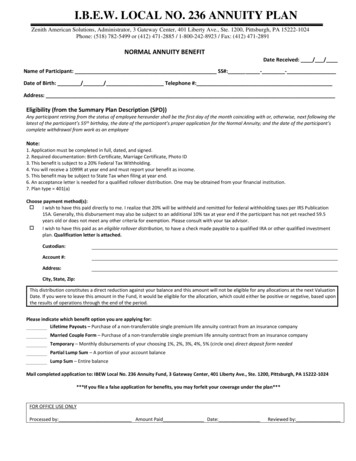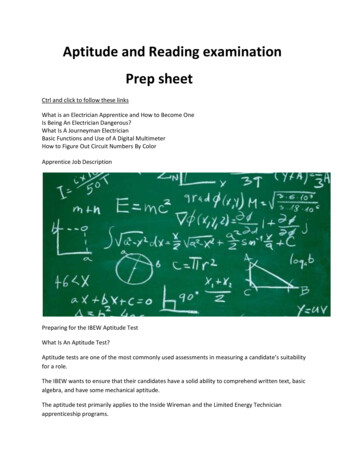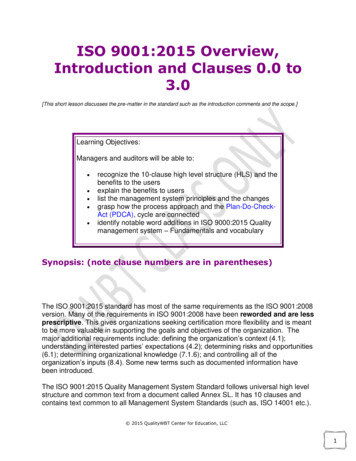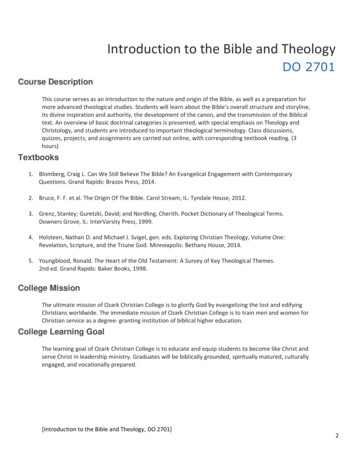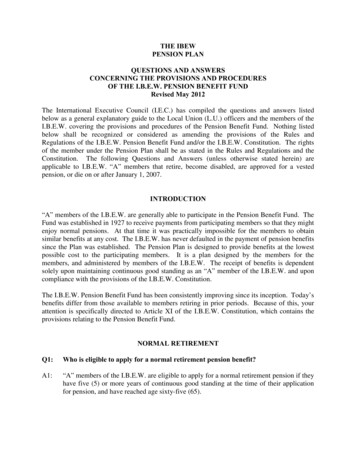
Transcription
THE IBEWPENSION PLANQUESTIONS AND ANSWERSCONCERNING THE PROVISIONS AND PROCEDURESOF THE I.B.E.W. PENSION BENEFIT FUNDRevised May 2012The International Executive Council (I.E.C.) has compiled the questions and answers listedbelow as a general explanatory guide to the Local Union (L.U.) officers and the members of theI.B.E.W. covering the provisions and procedures of the Pension Benefit Fund. Nothing listedbelow shall be recognized or considered as amending the provisions of the Rules andRegulations of the I.B.E.W. Pension Benefit Fund and/or the I.B.E.W. Constitution. The rightsof the member under the Pension Plan shall be as stated in the Rules and Regulations and theConstitution. The following Questions and Answers (unless otherwise stated herein) areapplicable to I.B.E.W. “A” members that retire, become disabled, are approved for a vestedpension, or die on or after January 1, 2007.INTRODUCTION“A” members of the I.B.E.W. are generally able to participate in the Pension Benefit Fund. TheFund was established in 1927 to receive payments from participating members so that they mightenjoy normal pensions. At that time it was practically impossible for the members to obtainsimilar benefits at any cost. The I.B.E.W. has never defaulted in the payment of pension benefitssince the Plan was established. The Pension Plan is designed to provide benefits at the lowestpossible cost to the participating members. It is a plan designed by the members for themembers, and administered by members of the I.B.E.W. The receipt of benefits is dependentsolely upon maintaining continuous good standing as an “A” member of the I.B.E.W. and uponcompliance with the provisions of the I.B.E.W. Constitution.The I.B.E.W. Pension Benefit Fund has been consistently improving since its inception. Today’sbenefits differ from those available to members retiring in prior periods. Because of this, yourattention is specifically directed to Article XI of the I.B.E.W. Constitution, which contains theprovisions relating to the Pension Benefit Fund.NORMAL RETIREMENTQ1:Who is eligible to apply for a normal retirement pension benefit?A1:“A” members of the I.B.E.W. are eligible to apply for a normal retirement pension if theyhave five (5) or more years of continuous good standing at the time of their applicationfor pension, and have reached age sixty-five (65).
Q2:What is the amount of this normal retirement pension?A2:The normal retirement pension of an “A” member is a benefit of four dollars and fiftycents ( 4.50) per month for each full year of continuous good standing as an “A”member, computed immediately prior to the month in which benefits begin.For example: An “A” member who was initiated into the I.B.E.W. in July,1990 and who applies for a pension on his sixty-fifth birthday inSeptember, 2030, with forty years of continuous good standing as an “A”member would begin to receive in October, 2030, a normal benefit of 180.00 per month as follows: 4.50 x 40 years for a Monthly Benefit of 180.00Q3:What if an “A” member reaches age 65 but has less than 5 years of continuous goodstanding? Can he receive a partial pension?A3:An “A” member, upon reaching age sixty-five, who has fewer than five years incontinuous good “A” membership standing, will not be eligible for retirement benefits atthat time. He may continue his membership, however, until completing the required fiveyears’ standing and then apply for retirement benefits in the normal fashion. In theinterim, he would continue to enjoy the protection of the death benefits associated withthe plan. It should be understood that, even if a member retires from the electricalindustry, he can continue to pay his “A” membership dues and earn additional years ofgood standing. In this way, a member who is retired, but who has not satisfied the fiveyears of continuous good standing for a normal pension or the twenty years of goodstanding for an early or disability pension, can continue earning additional years of credituntil he is eligible to apply for a benefit.Q4:For pension benefit purposes, will all years of membership count in the computationof full years of continuous good standing?A4:No. Only those years of “A” membership which are in continuous good standing at thetime of application. If the member currently holds at least five years’ continuous goodstanding as an “A” member upon reaching sixty-five (65) or more years of age, then allof the member’s full years of continuous good standing as an “A” member will be used incomputing the pension to which he is entitled.Q5:Will a normal retirement pension be paid to a member automatically after themember qualifies for such a benefit?A5:No, the member must apply through his L.U. Financial Secretary for pension on theprescribed form, which will be obtained from the International Secretary-Treasurer(I.S.T.). Of course, in addition to satisfying the eligibility requirements of age 65 and 5years of continuous good standing, the member must be fully retired from the electricalindustry in order to receive his normal retirement pension benefit.2
Q6:Can an “A” member drop the pension benefit and still maintain the death benefitcoverage?A6:Not while still an active “A” member. After retirement under the Plan, however, all or aportion of the retiree’s monthly pension benefit can be waived upon the retiree’s requestwhile the death benefit remains in effect.Q7:Is a member who transfers from “A” to “BA” membership, or who fails to maintaincontinuous “A” membership, entitled to a refund?A7:No. The I.B.E.W. Pension Benefit Plan does not provide for refunds. Other thannecessary administrative expenses, the only payments made by the Plan are pension anddisability benefits paid to our members and surviving spouses and death benefits paid tosurviving beneficiaries.OPTIONAL EARLY RETIREMENT“A” members of the I.B.E.W. who have attained age sixty-two (62) with twenty (20) ormore years of continuous good standing as “A” members of the I.B.E.W. immediatelypreceding their application are eligible to apply for an early retirement pension upon theirfull and complete retirement from the industry.Q8:What is the amount of this early retirement pension?A8:The early retirement pension of an “A” member is a benefit of four dollars and fifty cents( 4.50) per month for each full year of continuous good standing as an “A” member,computed immediately prior to the month in which benefits begin, reduced by 6.66% foreach year (or part) the member is under age 65 at time of retirement.For example, if an “A” member applies for early retirement at age sixty-two (62) and willhave thirty (30) full years of continuous good standing as an “A” member in the monthimmediately preceding the effective date of his early retirement, the computation of themonthly benefit would be as follows: 4.50 x 30 (years of service) 135.00LESS6.66% (percentage reduction for year or part under age 65)x3(years under age 65)19.98% (percentage reduction) 135.00x 19.98% 26.97 (amount of early retirement reduction)3
135.00 (full benefit)- 26.97 (less reduction) 108.03 (monthly early retirement pension)Q9:Can a member with fewer than 20 years of continuous good standing as an “A”member, but more than 5 years, retire prior to age 65 under the early retirementoption?A9:No. In order for a member with fewer than 20 years to receive a pension benefit, themember must continue to pay “A” member’s dues until he reaches age 65.Q10: How does a member arrange to begin receiving early retirement benefits?A10:Applications for all pension benefits are online at www.ibew.org or available at the L.U.office. The member must take the correctly completed application to the FinancialSecretary of the L.U. who will report on it at the L.U. meeting and shall then forward theproperly signed and sealed application to the I.S.T. In addition to satisfying theeligibility requirements, the member must be completely retired from the electricalindustry in order to receive early retirement pension benefits.Q11: Can a retired member return to work at the electrical industry and waive themonthly retirement benefits for the period he is working and then have the pensionbenefit payments resume when he ceases to work?A11:Yes, in fact it is mandatory that a retiree who returns to work in the electrical industrynotify his L.U. and notify the I.S.T. to cease paying the monthly pension benefit. Themember must immediately resume the payment of membership dues through his L.U.When the member again retires, he must advise his Financial Secretary who will notifythe I.S.T. so that pension payments can be resumed.Q12: Can a member who elected early retirement and subsequently returned to work andworked past age 65 then elect to receive benefits under the normal retirementprovisions?A12:No. A member who elects early retirement will always have that portion of his pensionbenefit determined on the basis of the early retirement provision. However, upon thesecond retirement such a member’s pension would be increased based on the additionalperiod of continuous good standing earned as an “A” member after his return to work.OPTIONAL SPOUSE’S BENEFITQ13: What is the optional spouse’s benefit?A13:An “A” member who qualifies for normal, early, or disability retirement may elect to4
receive a reduced pension benefit payable for the life of the member, with the provisionthat, upon the member’s death, one-half of the reduced pension will be paid to themember’s surviving spouse for as long as the spouse lives. If the spouse predeceases themember, or if the spouse and member divorce while the member is receiving the pensionbenefit, the member’s benefit will “pop-up” to the full amount. In either event, if thedeath or divorce occurred prior to January 1, 2002, the benefit will pop-up effectiveJanuary 1, 2002. If the death or divorce occurs on or after January 1, 2002, the benefitwill pop-up on the last day of the month following the death or divorce.Q14: Why is the amount of pension paid under the optional spouse’s benefit a reducedamount?A14:Since a second person (the spouse) may receive pension payments after the death of themember, the member’s pension has to be reduced in order to compensate for those extrapayments. The value to the member and spouse is the actuarial equivalent of the initialvalue of the member’s pension alone.Q15: How is the pension payable under the optional spouse’s benefit determined?A15:The pension benefit otherwise payable is multiplied by a factor which adjusts for theincreased period of pension payment. For the member and spouse whose ages are thesame, the pension is reduced to 86½ % of the otherwise payable amount. If the spouse isyounger than the member, the reduction is to 86½ % less ½ % for each year that thespouse is younger than the member. If the spouse is older than the member, the reductionis to 86½ % plus ½ % for each year that the spouse is older than the member. But at notime is the member’s benefit greater than 100%.Let’s look at some examples. We earlier presented an example where a member whoretires at age 65 with 40 full years of continuous good standing is entitled to a monthlypension benefit of 180.00. Suppose this member wishes to elect the optional spouse’sbenefit.1) If the member and his spouse are the same age, the pension is reduced to 86½% and the reduced pension payable would be:86.5 % x 180.00 155.70 per monthAfter the member’s death, one-half of this amount, or 77.85 per month,would continue to be payable as a pension to the surviving spouse.2) If the member’s spouse were 5 years younger than the member, the pensionwould be reduced to 86½ % less 5 x ½ %, or 84%. The reduced pensionpayable would be:84% x 180.00 151.20 per month5
One-half of this amount, or 75.60 per month, would be payable to thesurviving spouse.3) If the member’s spouse were 2 years older than the member, the pensionwould be reduced to 86½ % plus 2 x ½ % or 87½ %. The reduced pensionpayable would be:87.5 % x 180.00 157.50 per monthOne-half of this amount, or 78.75 per month, would be payable to thesurviving spouse.Q16: How do you calculate the reduced pension amount for an optional spouse’s benefitchosen in addition to early retirement?A16:First, the early retirement benefit to which the member is entitled must be calculated.Then this amount is multiplied by the reduction factor for an optional spouse’s benefit.This reduction factor for the optional spouse’s benefit is precisely the same for normal,early, and disability retirement. It depends only on the difference between the member’sage and the spouse’s age.Q17: How does a member arrange to receive the optional spouse’s benefit?A17:The member must apply on a form which will be obtained from the I.S.T. by themember’s L.U. Financial Secretary. If this election is desired, it shall be made prior toretirement so that the I.E.C. will have time to approve the application and have theoptional spouse’s benefit effective on the day the member is placed on pension.Q18: Can a member decide to elect the optional spouse’s benefit and then later change hismind and cancel the election?A18:The optional spouse’s benefit may be canceled up to the day the member is placed onpension. After that, it must remain in effect.Q19: What happens if the spouse dies subsequent to the member’s retirement?A19:In that case, the election is automatically canceled and the member will receive a “popup” of his pension. The benefit will equal the unreduced benefit the member would havereceived had the member never elected the optional spouse’s benefit. If the deathoccurred prior to January 1, 2002, the benefit will pop-up effective January 1, 2002. Ifthe death occurs on or after January 1, 2002, the benefit will pop-up on the last day of themonth following the death. Members should notify the I.S.T. immediately of the death oftheir spouse and provide a death certificate.Q20: What happens if the member and spouse divorce while receiving the optionalspouse’s benefit?6
A20:If the spouse and member were divorced prior to January 1, 2002, the optional spouse’sbenefit election is automatically canceled and beginning the month of January 2002, themember will receive a “pop-up” of his pension, an amount unreduced for the optionalspouse’s benefit. If the member and spouse divorce on or after January 1, 2002, themember will begin to receive the “pop-up” of his pension benefits on the last day of themonth following the date of the divorce. Members should notify the I.S.T. immediatelyof the divorce and provide copies of all divorce papers.Q21: If a retiree receiving the reduced optional spouse’s benefit dies prior to his spouse,what does the spouse need to do to receive the optional spouse’s benefit?A21:The spouse should notify the Fund immediately upon the death of the retiree and providethe Fund with a copy of the death certificate. To be eligible for the optional spouse’sbenefit, the surviving spouse must hold the relationship of spouse to the retiree atthe time of the retiree’s death.Q22: Who is considered a spouse for purposes of paying an optional spouse’s benefit?A22:The Fund will generally recognize a spouse who is named on a marriage certificate as themember’s spouse. In addition, the Fund will recognize what it has defined as a commonlaw marriage. To establish a common-law marriage as defined by the Fund, a membermust show to the satisfaction of the Trustees, cohabitation consciously and openly ashusband and wife, and a holding out to the public of the relationship as one of husbandand wife. Cohabitation alone does not establish a common-law marriage.To demonstrate to the Trustees that the member and his spouse were common-lawhusband and wife, as defined herein, the claimant may submit documents that show thatthe member and his spouse considered themselves, and acted as, husband and wife; suchdocuments include: jointly filed income tax returns, deeds to real estate, children’s birthcertificates, insurance policies showing family or joint coverage, announcements, etc.Based on the documents and information available, including information submitted, theTrustees shall determine whether the claimant satisfies the Fund’s definition of acommon-law spouse.In all events, to be considered a “spouse” for payment of the PBF optional spouse’sbenefit, the individual must continue to be married to the retiree at the time of theretiree’s death.RETIREMENT BENEFITS, VESTED PENSIONSAND OPTIONAL SPOUSE’S BENEFITS OF 30.00 OR LESSQ23: Are there situations where a member’s benefit or an optional spouse’s benefit maybe paid as a lump sum benefit?7
A23:Yes. In fact, members who would begin receiving a retirement pension or a vestedpension on or after January 1, 2003, will have their benefit paid as a lump sum benefit ifthe monthly benefit would be 30.00 or less. Similarly, spouses who would beginreceiving an optional spouse’s benefit of 30.00 or less on or after January 1, 2003, willreceive a lump sum instead of a monthly pension. This lump sum benefit will not be paidto members receiving a disability pension. Please note the Canadian lump sum amount issubject to change based on the equivalent US Dollar amount as defined in question 26below.Q24: How is the lump sum benefit calculated?A24:The lump sum benefit is calculated using actuarial tables supplied by the Fund’sactuaries. The benefit is the actuarial equivalent to the benefit the member or spousewould receive during their lifetime.Q25: What if I receive a lump sum payment and then return to work in the electricalindustry?A25:If you have received a lump sum payment, your entire retirement benefit has been paid.To earn additional retirement benefits, you must qualify again by earning a minimum offive years of continuous good standing as an “A” member.Q26: How does the Fund calculate whether I am receiving a monthly benefit of 30.00 orless when I am receiving a benefit in Canadian currency?A26:The 30.00 or less benefit is based on the U.S. dollar and the Fund will convert foreigncurrency to the U.S. dollar equivalent to determine whether the benefit is 30.00 or less.Q27: What if am receiving a benefit greater than 30.00, but I subsequently get divorcedand my ex-spouse and I both commence to receive less than 30.00?A27:In that case, your benefits will be paid as a lump sum. If only one of you receives 30.00or less, only that individual will receive the lump sum. Further, if we pay either of you alump sum and your ex-spouse predeceases you, you will not be eligible for the “pop-up”benefit.TOTAL DISABILITY PENSIONQ28: How many years of continuous good standing as an “A” member of the I.B.E.W.must a member have in order to be eligible for total disability benefits?A28:A member must have 20 or more years immediately preceding his application.Q29: How does a member obtain total disability pension benefits?8
A29:An “A” member who seeks total disability benefits must submit an application for them.The I.E.C. will approve this application once it has confirmed that the member is totallydisabled for disability pension benefit purposes and satisfies the service requirements.The member must maintain his or continuous good standing as an “A” member until thedate of approval or his application for total disability benefits.Q30: When can a member apply for disability pension?A30:Anytime after the onset of disability. In most cases, though, it will be a few monthsbefore it’s really clear that the disability is permanent. Many members will find it moreconvenient to apply at the same time they apply for Social Security or Canada Pensionbenefits because the same proof of disability is required.Q31: What does an “A” member have to do to prove that he is totally disabled forpension purposes?A31:Any “A” member will normally be presumed to be totally disabled for disability pensionbenefit purposes if the member presents evidence:(1)(2)(3)(4)That he has been awarded Social Security Total Disabil
THE IBEW . PENSION PLAN . QUESTIONS AND ANSWERS . CONCERNING THE PROVISIONS AND PROCEDURES . OF THE I.B.E.W. PENSION BENEFIT FUND . Revised May 2012 . The International Executive Council (I.E.C.) has compiled the questions and answers listed below as a general explanatory guide to the Local Union (L.U.) officers and the members of theFile Size: 241KB

